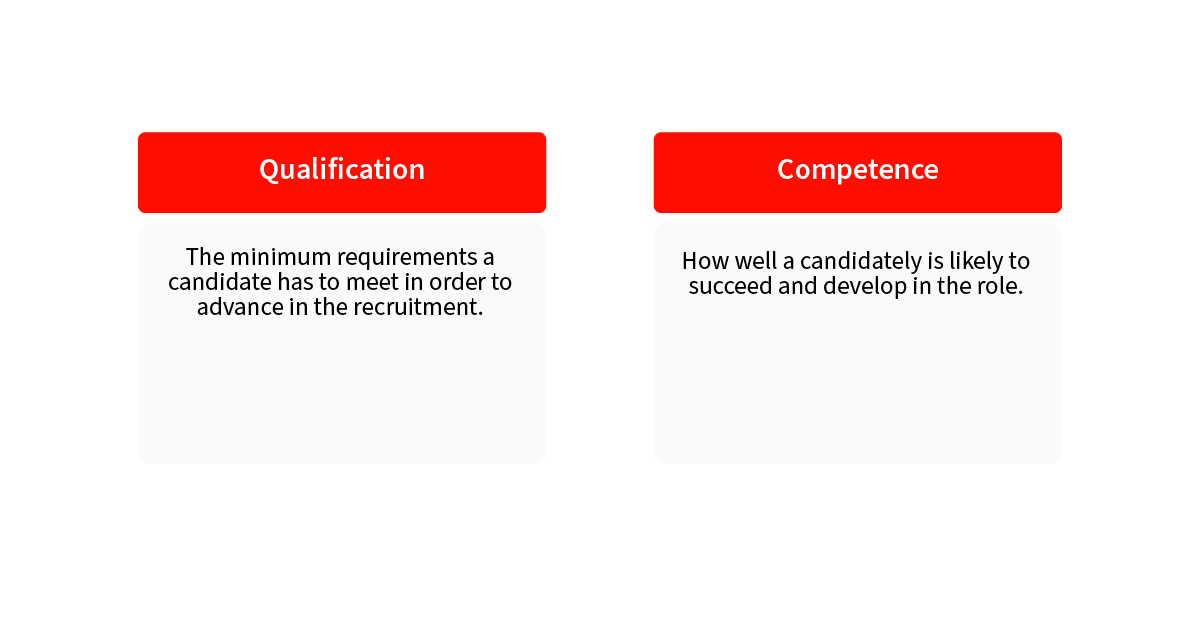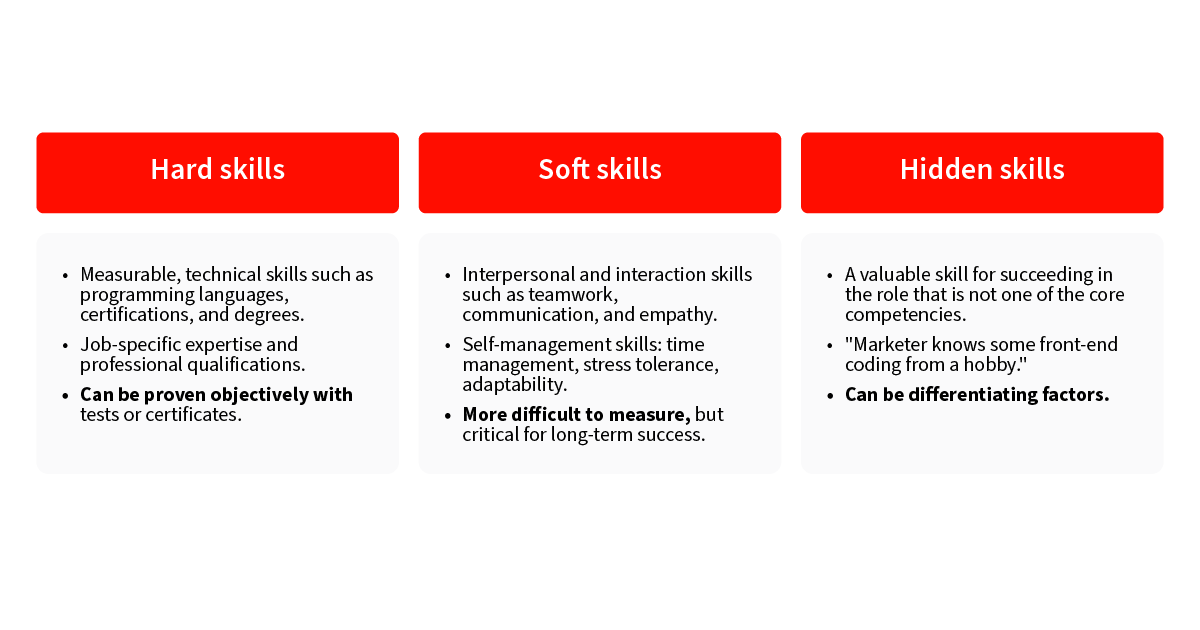Janne Malmisaari
Marketing Manager
In addition to his marketing expertise, Janne has 5 years of experience from talent acquisition for multiple industries.

Talent Acquisition
Hiring decisions often hinge on a couple of “ole faithfuls”: a hard scan of a CV’s work experience section, and that infamous “gut feeling”. However, these methods don't always reveal the full spectrum of an ideal candidate's true potential. If you want to modernize your talent acquisition practices, the answer is skills-based hiring
Skills-based recruitment, or competency-based recruitment, offers a more objective and structured approach to recruitment. It helps you identify the key skills and competencies most likely to drive success in a role.
And the numbers back this up. A Fortune article highlighted that 92% of employers surveyed saw skills-based hiring surpassing traditional CVs in identifying skilled candidates. Moreover, over 80% found that it leads to better performance and longer tenures for new hires.
By the end of this blog, you’ll understand:
Skills-based hiring evaluates candidates based on their skills and competencies, measured against a clearly defined set of requirements for the role.
How does skills-based hiring differ from traditional recruitment? It shifts the focus from traditional indicators like educational background or years of experience (qualifications) to what a candidate can truly do (competencies). This distinction between qualifications and competencies is important to understand. Let’s consult the illustration below:

While formal qualifications are important (more so in some roles than others), hiring purely based on them rarely yields the best results. Skills-based recruitment doesn’t, of course, outright dismiss them, but aims to support them with a more detailed evaluation of the candidate’s skillset.
One way to look at it is to see qualifications as minimum requirements and competencies as a way to assess how likely the person is to succeed in the position. Keep in mind that a candidate with a master’s degree and 5+ years of experience isn’t automatically more skilled than a candidate with a bachelor’s and 3 years of experience in similar roles.

Now you might be asking: What exactly are competencies? Let’s delve into that next!
What are skills and competencies in the context of skills-based hiring?
Some might say skills-based hiring focuses solely on assessing hard skills – this is a very narrow view. In any role, a candidate’s full skillset is revealed only by looking at the full picture: hard skills, soft skills, and even hidden skills.

How can competencies be assessed and measured? To effectively gauge real-world ability, skills-based hiring often utilizes practical assessments designed to measure specific competencies. For some roles, such as software developers, it is easy to prepare and evaluate practical work assessments. Other roles are more dependent on hard skills that are more difficult to measure and quantify, or the most relevant competencies are soft skills.
Soft skills and hard-to-measure hard skills can be evaluated by incorporating structured interviews. By asking relevant, predetermined questions, interviewers can get a better overview of candidates’ skill sets and achievements. An example of a skills-based question in a structured interview could be:
“Describe a time when you faced a significant unexpected challenge in a previous role. What steps did you take to analyze the situation, develop a solution, and implement it? What was the outcome, and what did you learn from the experience?”
Structured interviews also make it easier to compare candidates, since they have all answered the same questions.
Another great tool to enhance competency-based recruitment is personality assessments. Personality assessments are designed to help recruiters identify how likely the candidate is to succeed in a given role by assessing competencies closely related to the role.
Protip: Personality assessments can be used in different stages of the recruitment process.
The benefits of skills-based recruitment range from improved recruitment metrics to concrete business results and a better employer brand.
Skills-based hiring helps you gain a “360-degree” overview of the candidate’s profile. This results in better quality of hire and improved retention rates.
Stronger employee retention lowers recruitment costs. Additionally, a decrease in turnover saves valuable time and resources by minimizing gaps in key positions and reducing the number of onboarding processes for new hires still getting up to speed.
Skills-based hiring, when done right, can also have a huge impact on candidate experience. In addition to a unified and equal hiring process, thorough skills-based evaluations help you provide rejected candidates with detailed and personalized feedback.
Skills-based hiring can also help you promote DEI (Diversity, Equity, and Inclusion) inside your organization. It helps eliminate biases from recruitment by unifying the process and how candidates are evaluated, focusing on objectively assessable criteria. LinkedIn’s 2023 Global Talent Trends report found that companies using skills-based processes were 50% more likely to achieve their DEI goals.

We live in an era where work-life is increasingly dynamic, and the adage, “the only constant is change,” is perhaps more relevant than ever.
The World Economic Forum highlights the massive scale of future reskilling needs, projecting that over a billion people will require new skills due to technological advancements in the workplace. AI’s rapid development is sending shockwaves through industries. Professionals must continuously reskill themselves, and recruiters are required to identify candidates with strong adaptability and a commitment to continuous learning.
Rise of Gen-Z in the workforce will also have an impact, as the traditional emphasis on college degrees is facing increasing scrutiny from them. A survey revealed that about 77% of respondents view it as “outdated” to assume a degree is necessary for a successful career, with only half agreeing that college is a valuable investment. This aligns with the growing importance of skills-based hiring.
Skills-based hiring helps talent acquisition professionals revamp their recruitment processes to better fit both current and future job market needs.
Hopefully, you are now more well-versed in skills-based hiring’s definition, positive impacts, and significance in talent acquisition.
If you wish to learn more about how to implement skills-based hiring practices, read our 6-point checklist for HR Managers and Recruiters.
Blog
Top 10 Recruitment Trends for 2026
Blog
How to Adopt Skills-Based Hiring: 6-Point Checklist for HR Managers and Recruiters
Blog
Human-Centered Recruitment – A Meaningful Experience for Both Candidates and Recruiters
Blog
Job Search And AI: What Recruiters Should Know About Candidates Using AI